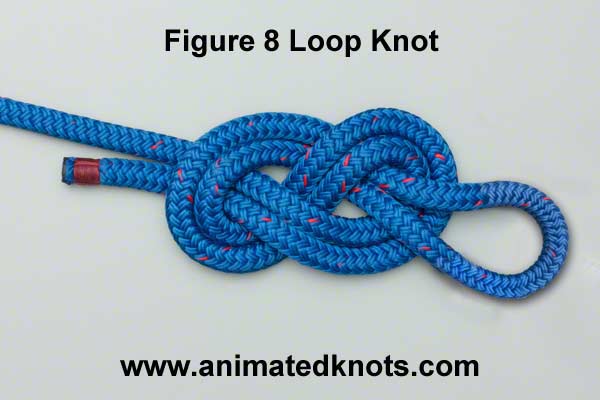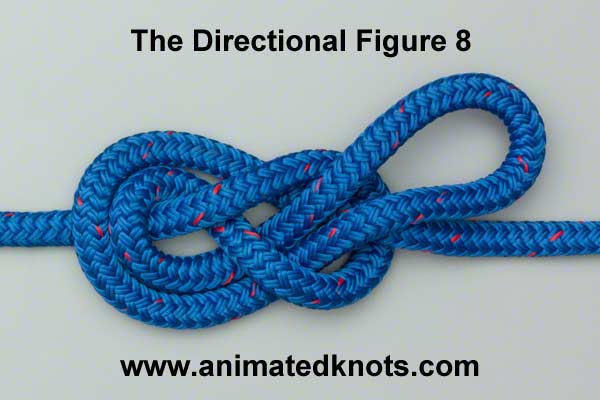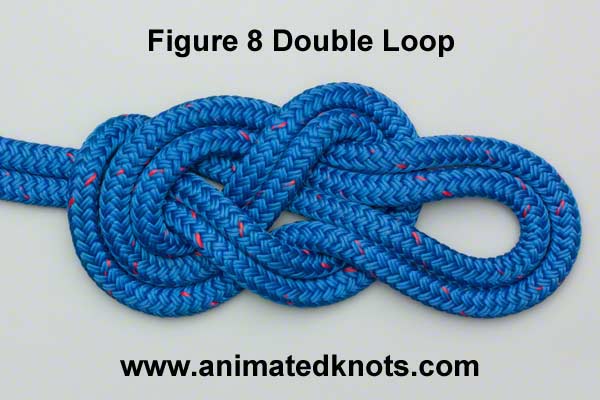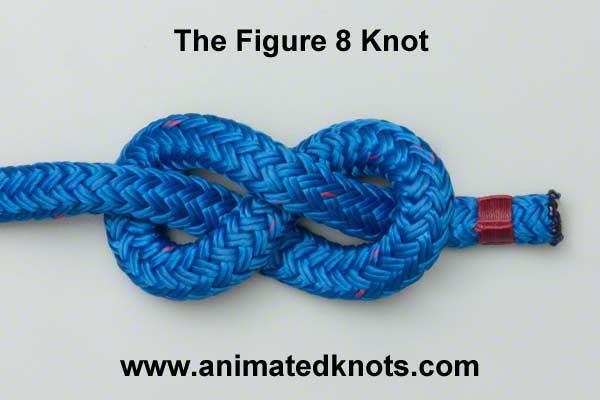Figure-eight loop
The figure-eight knot with a loop or Anseilknoten used for linking a particularly secure safety strap.
- 3.1 Double Figure Eight Knot
- 3.2 Plugged eight knot
Name and history
The name derives from its shape, which looks like an eight (8). If the node is made with " double-layer " rope, the name Double Figure Eight knot is common. More nodes with a " 8- shape " have similar and partly overlapping names; an overview can be found at Endacht.
The figure eight knot is now teaching all alpine organizations (DAV, PES, SAC, J S, Mountain Rescue ), as well as of all rescue organizations (DRC, WCC, SRK, fire brigade, THW, mountain rescue, water rescue, DLRG, SLRG, civil protection ).
Until the 1980s, the figure-eight knot in the alpine area was virtually unknown. Used climber earlier than the tie-in loop the fisherman's knot and the leader node, and as a " harness " the double rescue sling or a " sling seat ".
In the maritime sector, double figure eight knot plays almost no role. Instead there, the bowline is used as a fixed loop for almost all applications. The figure-eight knot Endachtknoten, (one night ) safeguards as a stopper knot the end of a sheet from slipping by a roller or a stopper.
Application
The figure eight knot is used as a particularly secure fixed loop. A plugged -eight knot for joining two ropes is called Flemish eight knot.
The decisive factor is the high strength: the rope retains 63 % of its tensile strength. The figure eight knot is thus superior to almost every other loop nodes ( see table at node strength). At the same time the figure-eight knot is easily be removed even after high or repeated exposure. Both are especially important for shock loading and makes it an ideal node for roping in climbing.
On harness
The figure eight knot is used in climbing and rescue services as a secure connection between climbing rope and harness. In the end of the rope a figure-eight knot is tied so that there is still about a meter cable end free. This end of the rope is now pulled through the attached to the harness tie-in loop, and then threaded back the eight nodes along parallel. This form is also called eingebundener or inserted eight knot ( see below).
Warning: Embed Achterknoten always right in the harness, especially when lead climbing and walking or skiing in the rope team ( never a carbine in between, because often results in the overthrow of serious head, jaw and dental injuries Furthermore, the fracture load lowers the. safety chain by possible lateral load in the carbine considerably ).
Exception: In some climbing gyms are backed with top-rope ropes of the figure-eight knot with heat shrink tubing so that inexperienced climbers not untie the knot and tie back together wrong. If the figure-eight knot so can not be directly involved in the harness, the Association recommends using two counter-rotating snap hooks or a self-locking or locking carabiner secured such as Ball Lock Carabiner by Petzl Belay Master or DMM. When climbing, lead climbing such a combination is but life-threatening.
At the snap hook
The figure eight knot is often used by fire and rescue services or in the army and in the building trade as a link between cable and specially shaped safety hooks, as the figure-eight knot is easy to visually check that the rope comparatively little weakens and therefore has a high breaking strength. Condition are specially shaped carabiner which exclude a transverse force and ideally have an auto locking mechanism. Normal carabiner ( as pictured) have already opened itself to use and led to fatal accidents.
Tie
Double Figure Eight Knot
Build a bay, put the now double rope a second bay, this twist twice, and insert the first bay through the eye of the double- twisted second bay. Moved results in the right image.
Plugged -eight knot
For the application to the harness of the figure-eight knot is inserted (see above): you make in the end of a rope a loose Endacht, so that there is still about a meter cable end free. This free end is carried by the tie-in loop the harness. And then follows with the end of the node profile ( now backward) exactly, then there is a figure-eight knot (a " Double overhand knot with the loop "). The rope is in the image series right from the node, the inserted loop is left.
Alternatives
- Highest knot strength reaches a half times Bulin and is easier to solve by load, but visually harder to control.
- If a fixed loop needed in the middle of a rope, the butterfly knot is recommended.
- If the node is not to be used for climbing or for other security purposes, but simply a fixed loop is used, the bowline is recommended. In the maritime field, he is so far almost always preferred the figure-eight knot. If the cable can not be overlaid on the object is the bowline faster to make than the figure-eight knot and he's always easy to solve.
Modifications
- If the inserted figure-eight knot tied with simple rope, the Flemish eight knot forms a particularly secure connection between two ropes.
- Just simply attached his name Endacht and serves as a thickening at the end of a rope.
- Turning the double loop during knotting only once, gives the leader node.
- Turning the double loop during knotting once again produced the nine nodes. It is slightly larger and has a less distinct appearance, runs under load but at a considerably less.
- If you want to place a loop two loops ( So a two figure-eight knot, which also rabbit ears nodes is called by the industrial climbers ), the bay is only half pushed through the almost finished knot and slipped the still protruding bay down over the "smaller" two bays, according to on top of the "head of the 8 " tightened down and the end. Similar offers two loops, for example, the double bowline.
- Also can be further loops with the double overhand knot produce. However, this requires a slight change in Knüpfvariante. We start as in the zweischlaufigen node, but the bay is not placed down over the two bays, but in reverse, put on the "head of the 8 " back to the two existing bays. The rest of the sequence as usual, sort and tighten the individual loops.
- The combination of two loops and triple loop ( retrying loops, to use a very long bay as a starting point! ) So many multiple loops can be produced, but only find their meaning in scoubidou and macrame. For example, a " peacock's tail " with more than eight loops.










